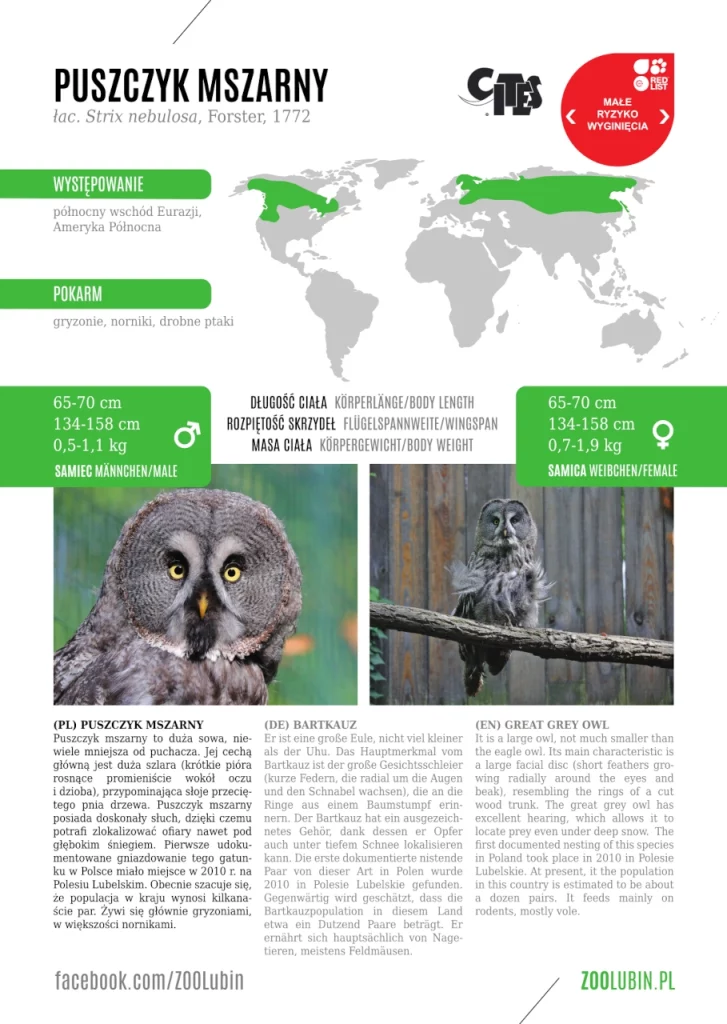
POBIERZ ETYKIETĘ GATUNKOWĄ – PLIK PDF (rozmiar 2228 KB)
Puszczyk mszarny (PL)
łac. Strix nebulosa lapponica, Forster, 1772
Puszczyk mszarny to duża sowa, niewiele mniejsza od puchacza. Jej cechą główną jest duża szlara (krótkie pióra rosnące promieniście wokół oczu i dzioba), przypominająca słoje przeciętego pnia drzewa. Puszczyk mszarny posiada doskonały słuch, dzięki czemu potrafi zlokalizować ofiary nawet pod głębokim śniegiem. Pierwsze udokumentowane gniazdowanie tego gatunku w Polsce miało miejsce w 2010 r. na Polesiu Lubelskim. Obecnie szacuje się, że jego populacja w kraju wynosi kilkanaście par. Żywi się głównie gryzoniami, w większości nornikami.
Występowanie: północny wschód Eurazji, Ameryka Północna
samiec / samica
Długość ciała: 65-70 cm
Rozpiętość skrzydeł: 134-158 cm
Masa ciała: 0,5–1,1 kg / 0,7–1,9 kg
Bartkauz (DE)
łac. Strix nebulosa lapponica, Forster, 1772
Es ist eine große Eule, nicht viel kleiner als der Uhu. Das Hauptmerkmal des Bartkauzes ist der große Gesichtsschleier (kurze Federn, die radial um die Augen und den Schnabel wachsen), der an die Ringe eines Baumstumpfs erinnern. Der Bartkauz hat hervorragendes Gehör, dank dessen er Opfer auch unter tiefem Schnee lokalisieren kann. Das erste in Polen brütende Paar wurde 2010 in Polesie Lubelskie gefunden. Gegenwärtig wird die polnische Population auf etwa ein Dutzend Paare geschätzt. Bartkauz ernährt sich hauptsächlich von Nagetieren, meistens Feldmäusen.
Vorkommen: Nordosten Eurasiens, Nordamerika
Männchen / Weibchen
Körperlänge: 65-70 cm
Flügelspannweite: 134-158 cm
Körpermasse: 0,5–1,1 kg / 0,7–1,9 kg
Great grey owl (EN)
łac. Strix nebulosa lapponica, Forster, 1772
It is a large owl, not much smaller than the eagle owl. Its main characteristic is the large facial disc (short feathers growing radially around the eyes and beak), resembling the rings in a cross-section of a wood trunk. The great grey owl has excellent hearing, which allows it to locate prey even under deep snow. The first documented nesting of this species in Poland took place in Polesie Lubelskie in 2010. At present, its population in this country is estimated to be about a dozen pairs. It feeds mainly on rodents, mostly vole.
Distribution: northeastern part of Eurasia, North America
male / female
body length: 65-70 cm
wingspan: 134-158 cm
body mass: 0,5–1,1 kg / 0,7–1,9 kg
